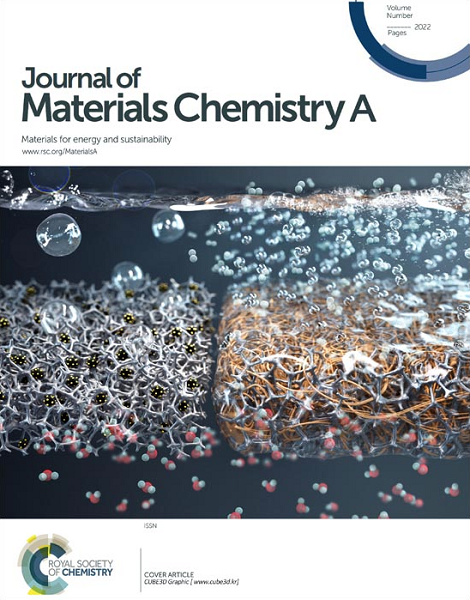微波冲击驱动非常规立方二维LaMnO3高效析氧热工程
IF 9.5
2区 材料科学
Q1 CHEMISTRY, PHYSICAL
引用次数: 0
摘要
二维(2D)钙钛矿氧化物的相工程为增强析氧反应(OER)提供了强有力的策略,但在保持其精致的二维形态的同时合成非常规相是一个重大挑战。其中,LaMnO3的立方相由于其优越的电子和结构性能而具有很大的发展前景,但其形成受到高热力学势垒的阻碍。在此,我们提出了一种微波冲击驱动的合成方法,克服了这些限制,使快速制造具有保留多孔二维结构的三相LaMnO3纳米片成为可能。该方法利用超快的热梯度来诱导相变,绕过了传统合成路线的高能限制。立方LaMnO3催化剂表现出优异的OER活性,在10 mA cm−2条件下过电位为290 mV,在1.0 M KOH条件下Tafel斜率为66.21 mV dec−1。密度泛函理论(DFT)计算表明,立方对称优化了Mn 3d和O 2p轨道杂化,增强了电荷转移和氧中间体活化。这项研究证明了微波冲击驱动相工程作为设计高性能二维电催化剂的强大平台的潜力,为先进催化剂的开发提供了新的见解。本文章由计算机程序翻译,如有差异,请以英文原文为准。

Microwave shock-driven thermal engineering of unconventional cubic 2D LaMnO3 for efficient oxygen evolution
The phase engineering of two-dimensional (2D) perovskite oxides offers a powerful strategy for enhancing the oxygen evolution reaction (OER), but synthesizing unconventional phases while maintaining their delicate 2D morphology poses significant challenges. Among these, the cubic phase of LaMnO3 holds great promise due to its superior electronic and structural properties, yet its formation is hindered by high thermodynamic barriers. Herein, we present a microwave shock-driven synthesis approach that overcomes these limitations, enabling the rapid fabrication of cubic-phase LaMnO3 nanosheets with a preserved porous 2D architecture. This method leverages ultrafast thermal gradients to induce phase transitions, bypassing the high-energy constraints of conventional synthesis routes. The cubic LaMnO3 catalyst exhibits outstanding OER activity, achieving a low overpotential of 290 mV at 10 mA cm−2 and a Tafel slope of 66.21 mV dec−1 in 1.0 M KOH. Density functional theory (DFT) calculations reveal that cubic symmetry optimizes Mn 3d and O 2p orbital hybridization, enhancing charge transfer and oxygen intermediate activation. This study demonstrates the potential of microwave shock-driven phase engineering as a robust platform for designing high-performance 2D electrocatalysts, offering new insights into advanced catalyst development.
求助全文
通过发布文献求助,成功后即可免费获取论文全文。
去求助
来源期刊

Journal of Materials Chemistry A
CHEMISTRY, PHYSICAL-ENERGY & FUELS
CiteScore
19.50
自引率
5.00%
发文量
1892
审稿时长
1.5 months
期刊介绍:
The Journal of Materials Chemistry A, B & C covers a wide range of high-quality studies in the field of materials chemistry, with each section focusing on specific applications of the materials studied. Journal of Materials Chemistry A emphasizes applications in energy and sustainability, including topics such as artificial photosynthesis, batteries, and fuel cells. Journal of Materials Chemistry B focuses on applications in biology and medicine, while Journal of Materials Chemistry C covers applications in optical, magnetic, and electronic devices. Example topic areas within the scope of Journal of Materials Chemistry A include catalysis, green/sustainable materials, sensors, and water treatment, among others.
 求助内容:
求助内容: 应助结果提醒方式:
应助结果提醒方式:


